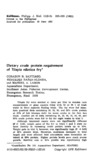Dietary crude protein requirement of Tilapia nilotica fry
Share
抄録
Tilapia fry were stocked at three per liter in wooden tank compartments or glass aquaria filled with 50 or 35 l of fresh water in three separate feeding trials. The fry were fed isocaloric practical diets containing 20, 25, 30, and 35% crude protein at 15% of fish biomass daily for seven weeks in the first tow trials. Another set of diets containing 20, 25, 30, 35, 40, 45, and 50% crude protein were fed to fry for eight weeks in trial 3.
Although treatment means were not significantly different (P< 0.05), weight gains of the fry in trials 1 and 2 were related directly to increasing crude protein levels up to 35%. Weight gain in trial 3, however, was significantly high (P < 0.05) at 35% protein level. Moreover, maximum increases in total length and most efficient feed conversions were invariably attained at 35% protein. Higher protein levels gave much poorer growth. Survival rate at 35% protein was significantly high (P < 0.05) compared to 20% (trial 1) or 30% (trial 2) protein level. In trial 3, survival at 35% protein was not significantly different from all other treatments. Maximum growth, best feed conversion, and high survival were attained with the 35% protein diets.
Suggested Citation
Santiago, C. B., Bañes-Aldaba, M., & Laron, M. A. (1982). Dietary crude protein requirement of Tilapia nilotica fry. Kalikasan: The Journal of Philippine Biology , 11(2-3), 255-265. http://hdl.handle.net/10862/1048
Collections
- AQD Journal Articles [1249]

